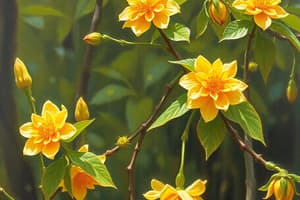Podcast
Questions and Answers
What is the primary focus of phytochemistry?
What is the primary focus of phytochemistry?
- Examining the chemistry of plant-derived compounds (correct)
- Knowing the history of medicinal plants
- Studying the growth patterns of plants
- Analyzing soil composition for plant growth
Which class of compounds includes proto-alkaloids and true alkaloids?
Which class of compounds includes proto-alkaloids and true alkaloids?
- Carbohydrates
- Alkaloids (correct)
- Tannins
- Glycosides
What is a main step involved in the study of phytochemistry?
What is a main step involved in the study of phytochemistry?
- Creation of artificial plant compounds
- Photographic documentation of plants
- Erosion control in plant habitats
- Authentication and extraction of plant materials (correct)
Which compound is NOT typically studied within the framework of phytochemistry?
Which compound is NOT typically studied within the framework of phytochemistry?
What is a significant purpose of pharmacological assessment in phytochemistry?
What is a significant purpose of pharmacological assessment in phytochemistry?
Which technique is likely to be used in the extraction of volatile oils?
Which technique is likely to be used in the extraction of volatile oils?
Historically, who significantly contributed to the understanding of compounds like citric and gallic acids?
Historically, who significantly contributed to the understanding of compounds like citric and gallic acids?
Which of the following best describes tannins?
Which of the following best describes tannins?
What does a green-blue color indicate in the Keller-Kiliani test?
What does a green-blue color indicate in the Keller-Kiliani test?
In the Liebermann-Burchard reaction, what color indicates the presence of steroids?
In the Liebermann-Burchard reaction, what color indicates the presence of steroids?
What does a color change from yellow to red shades in sodium picrate paper indicate?
What does a color change from yellow to red shades in sodium picrate paper indicate?
Which test results in a pink-red color in the alkaline layer to indicate the presence of free anthraquinones?
Which test results in a pink-red color in the alkaline layer to indicate the presence of free anthraquinones?
What is the purpose of adding concentrated Sulphuric acid in the Liebermann-Burchard reaction?
What is the purpose of adding concentrated Sulphuric acid in the Liebermann-Burchard reaction?
What step is involved when testing for anthraquinone glycosides after boiling the solution with sulphuric acid?
What step is involved when testing for anthraquinone glycosides after boiling the solution with sulphuric acid?
Which compound does NOT result in a color change indicating its presence in the tests described?
Which compound does NOT result in a color change indicating its presence in the tests described?
In the free anthraquinones test, what is done after boiling and cooling the mixture?
In the free anthraquinones test, what is done after boiling and cooling the mixture?
What was the primary focus of early phytochemical studies?
What was the primary focus of early phytochemical studies?
What does the preliminary phytochemical screening test accomplish?
What does the preliminary phytochemical screening test accomplish?
In the test for tannins, what indicates their presence?
In the test for tannins, what indicates their presence?
Which reagent is NOT used in the test for alkaloids?
Which reagent is NOT used in the test for alkaloids?
What role does phytochemistry play in herbal medicine?
What role does phytochemistry play in herbal medicine?
What is one main reason for using phytochemical methods in drug discovery?
What is one main reason for using phytochemical methods in drug discovery?
What is the significance of active principles in plant extracts?
What is the significance of active principles in plant extracts?
Which method is used to perform the test for the presence of tannins?
Which method is used to perform the test for the presence of tannins?
Flashcards
What is phytochemistry?
What is phytochemistry?
The study of plants and their chemical compounds, including identification, extraction, isolation, characterization, biosynthesis, and pharmacological effects.
Authentication and extraction of plant material
Authentication and extraction of plant material
A process of identifying and extracting plant material for analysis and study.
Separation and isolation of plant constituents
Separation and isolation of plant constituents
Separating and isolating specific compounds of interest from a plant extract.
Characterization of plant compounds
Characterization of plant compounds
Signup and view all the flashcards
Investigation of biosynthetic pathways
Investigation of biosynthetic pathways
Signup and view all the flashcards
Quantitative evaluations
Quantitative evaluations
Signup and view all the flashcards
Pharmacological assessment of plant components
Pharmacological assessment of plant components
Signup and view all the flashcards
Historical development of phytochemistry
Historical development of phytochemistry
Signup and view all the flashcards
Keller-Kiliani Test
Keller-Kiliani Test
Signup and view all the flashcards
Liebermann-Burchard Reaction
Liebermann-Burchard Reaction
Signup and view all the flashcards
Cyanogenic Glycosides Test
Cyanogenic Glycosides Test
Signup and view all the flashcards
Free Anthraquinones Test
Free Anthraquinones Test
Signup and view all the flashcards
Anthraquinone Glycosides Test
Anthraquinone Glycosides Test
Signup and view all the flashcards
Precipitate Colors and Alkaloids
Precipitate Colors and Alkaloids
Signup and view all the flashcards
Alkaloid Tests
Alkaloid Tests
Signup and view all the flashcards
Alkaloids
Alkaloids
Signup and view all the flashcards
Early Phytochemistry
Early Phytochemistry
Signup and view all the flashcards
Modern Phytochemistry Focus
Modern Phytochemistry Focus
Signup and view all the flashcards
Preliminary Phytochemical Screening Test
Preliminary Phytochemical Screening Test
Signup and view all the flashcards
Test for Tannins
Test for Tannins
Signup and view all the flashcards
Test for Alkaloids
Test for Alkaloids
Signup and view all the flashcards
Phytochemical Approach to Drug Discovery
Phytochemical Approach to Drug Discovery
Signup and view all the flashcards
Bioactive Compounds in Plants
Bioactive Compounds in Plants
Signup and view all the flashcards
Study Notes
Phytochemistry General Introduction
- Phytochemistry is the study of plant compounds and their properties
- This includes their chemistry, biological activity, and structure-activity relationships
Course Objectives
- Describe the chemistry and biological activity of volatile oils, resins, carbohydrates, alkaloids, glycosides, and tannins.
- Describe the structure-activity relationships of biologically active components.
- Recognize and draw chemical structures of active components.
- Describe the physical and chemical properties of active and inactive components.
Course Outline
- General introduction to phytochemistry, extraction, and isolation of natural products.
- Techniques commonly used in phytochemistry
- Volatile oils (e.g., terpenes, oxygenated terpenes, phenolic compounds)
- Alkaloids (e.g., proto-alkaloids, true alkaloids, tropane alkaloids)
- Carbohydrates
- Glycosides (e.g., alcoholic glycosides, anthraquinones, flavonoids, saponins)
- Tannins
- Bitter principles
- Resin and its combinations
What is Phytochemistry?
- Phytochemistry is the study of plants and their phytochemicals
- It involves:
- Authentication and extraction of plant material
- Separation and isolation of components of interest
- Characterization of isolated compounds
- Investigation of biosynthetic pathways to compounds
- Quantitative evaluations
- Pharmacological assessment of components
Historical Development of Phytochemistry
- Early knowledge of plant compounds: cane sugar, starch, camphor, benzoic acid, fats, volatile oils, resins, and their aqueous extraction.
- Key developments in the 17th-19th centuries:
- K. W. Scheel (German apothecary) isolated citric, gallic, prussic, oxalic, and tartaric acids.
- Nicholas Lemery (French apothecary) expanded the use of alcohol and solvents in extraction.
- Isolation of narcotine, the first alkaloid; later followed by morphine, strychnine, emetine, and more.
- Twentieth century focus: elucidation of biosynthetic pathways
The Recent Interest
- Focus on active principles (usually alkaloids or specific glycosides) with pronounced pharmacological properties.
- Emphasis on the plant as a source of new drugs and strategies for plant extract fractionation based on biological activity, rather than on particular chemical classes.
- Chemical examination follows active fraction isolation.
Techniques Used in Phytochemistry
- Methods for analyzing and isolating plant compounds.
Preliminary Phytochemical Screening Test
- Process for identifying plant constituents
- Widely used in quality control of herbal medicines, particularly Chinese herbal medicines.
- Identifies various components like alkaloids, saponins, and flavonoids.
- Often, biologically active compounds in herbal medicines remain undetermined.
Screening and Analysis of Bioactive Compounds
- Phytochemical methods used to screen and analyze bioactive compounds.
- Contributing to the discovery of new therapeutic compounds.
Test for Tannins
- To 2 mL of water extract of different plant parts, add 2 mL of 10% ferric chloride solution in a test tube.
- Blue-black precipitate indicates tannins.
Test for Alkaloids
- To 2 mL of methanolic extract of different plant parts, add 1 mL of 1% hydrochloric acid in a test tube. Heat in a water bath for 10 minutes.
- Take 1 mL from the solution and add 6 drops of Dragendorff's reagent, Wagner's reagent, or Mayor's reagent.
- Orange, brownish-red, or creamish precipitate indicates alkaloids.
Test for Cardiac Glycosides (Keller-Kiliani Test)
- To 2 mL of methanolic extract, add 1 mL of glacial acetic acid, 6 drops of 10% ferric chloride solution, and 6 drops of concentrated sulphuric acid in a test tube.
- A green-blue color indicates cardiac glycosides.
Test for Steroids and Terpenes (Liebermann-Burchard Reaction)
- To 2 mL of chloroform extract, add 2 mL of acetic anhydride and a few drops of concentrated sulphuric acid in a test tube.
- A blue-green ring between layers indicates steroids, and a pink-purple ring indicates the presence of terpenes.
Test for Cyanogenic Glycosides
- To 3 mL of ethanol extract, add 2 mL of sterile water in a conical flask.
- Place freshly prepared sodium picrate paper at the stopper. Heat the solution to boiling.
- A change in color of the sodium picrate paper from yellow to shades of red indicates cyanogenic glycosides.
Free Anthraquinones Test
- To 5 mL of ethanol extract of different plant parts, add 10 mL of water. Boil, cool and shake with 5 mL of chloroform.
- Concentrate the chloroform layer to 2 mL and add 2-3 mL of ammonia solution.
- A pink-red color in the alkaline layer indicates free anthraquinones.
Anthraquinone Glycosides Test
- To 2.5 g of powdered plant material, add 10 mL of 20% sulphuric acid and 2 mL of 2% ferric chloride solution.
- Boil in water bath (reflux) for 30 minutes, cool and filter.
- Extract the solution with 10 mL of chloroform in a separating funnel. Concentrate to 4 mL and add 2.5 mL of 10% ammonia solution.
- A pink-red color in the alkaline layer indicates anthraquinone glycosides.
Test for Flavonoids (Shinoda's Test)
- To 2 mL of ethanol extract, add 0.5 mL of concentrated hydrochloric acid and a few magnesium turning in a test tube.
- A pink-tomato red color indicates flavonoids.
Test for Volatile Oils
- To 0.5 mL of oil sample, add 2 drops of 1% aqueous FeCl3.
- Different colors indicate different volatile oils.
Studying That Suits You
Use AI to generate personalized quizzes and flashcards to suit your learning preferences.
Related Documents
Description
Explore the fundamental concepts of phytochemistry, focusing on the study of plant compounds and their properties. This quiz covers important topics such as volatile oils, alkaloids, and carbohydrates, as well as the techniques for extracting and isolating natural products. Test your understanding of chemical structures and the biological activity of various plant components.




